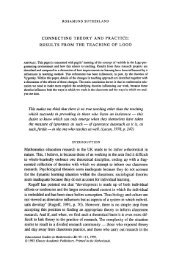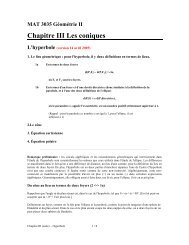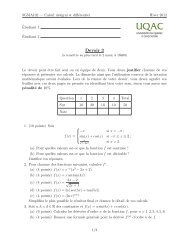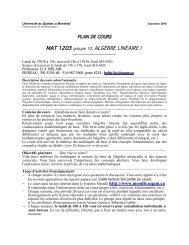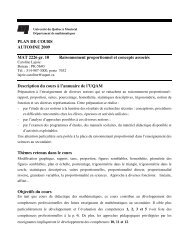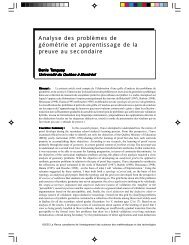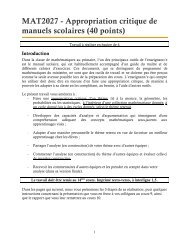COMPLEX GEOMETRY Course notes
COMPLEX GEOMETRY Course notes
COMPLEX GEOMETRY Course notes
Create successful ePaper yourself
Turn your PDF publications into a flip-book with our unique Google optimized e-Paper software.
5.5 Index Theorem (Heat Equation approach)<br />
Let ∆ p : A p (X) −→ A p (X), λ ∈ R ≥0 . Let E p λ denote the λ-eigenspace for ∆p (finite dimensonal). The<br />
square root √ ∆ = δ is called the Dirac operator.<br />
Lemma 5.5.1. The sequence<br />
is exact for λ > 0.<br />
0 −→ E 0 λ<br />
d<br />
−→ Eλ 1 d<br />
−→ · · · −→ Eλ n −→ 0<br />
Proof: ω ∈ E p λ =⇒ ∆p+1 dω = d∆ p ω = λdω =⇒ dω ∈ E p+1<br />
λ<br />
.<br />
Now ω ∈ E p λ and dω = 0 =⇒ λω = ∆p ω = d ∗ d + dd ∗ ω =⇒ ω = d ( 1<br />
λ d∗ ω ) . Then ∆d ∗ ω = d ∗ ∆ω = λd ∗ ω.<br />
Corollary 5.5.1. ∑ p (−1)p dim(E p λ ) = 0.<br />
Corollary 5.5.2. Let {λ p i } be the spectrum of ∆p , with terms repeated n times if multi = n. Then<br />
where ∑ ′<br />
i<br />
is over i where λ(p) i = 0.<br />
∑<br />
(−1) p tre −t∆p = ∑<br />
p<br />
p<br />
(−1) p e −tλ(p) i<br />
= ∑ p<br />
(−1) p ′∑<br />
i<br />
e −λ(p) i (t)<br />
Note that ∑ ′<br />
i e−λ(p) i<br />
(t) = dim(Ker(∆ p )). Hence<br />
X (X) = ∑ p<br />
= ∑ p<br />
(−1) p dim(Ker(∆ p )) = ∑ (−1) p tre −t∆(p) , where e −t∆(p) = T t ,<br />
p<br />
(−1) ∑ ∫<br />
p e (p) (x, x, t)dVol(x).<br />
i X<br />
Proposition 5.5.1. e(x, x, t) ∼ (4πt) −n/2 ∑ ∞<br />
k=0 u k(x, t)t k , where u k (x, t) is explicitly given in terms of<br />
components of curvatures.<br />
Hence, as t −→ 0, we have<br />
(<br />
X ∼ 1 n/2 ∑<br />
∞ ∫<br />
4πt<br />
k=0<br />
X<br />
)<br />
∞∑<br />
(−1) p tru p k (x, x)dVol(x) t k .<br />
p=0<br />
71



